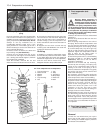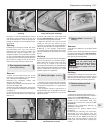
the front suspension tower and engaged with
further holes in the bottom coil spring seat. If
available use these, otherwise fit universal coil
spring compressors (see illustration). Do not
attempt to use any makeshift tool, as
considerable damage could occur if the
spring breaks free. To fit either type of tool it
will be necessary to turn the front wheel to full
lock in alternate directions.
2 Loosen, but do not remove, the three strut
top mounting nuts (see illustration).
3 Chock the rear wheels then jack up the
front of the car and support it on axle stands
(see “Jacking and vehicle support”). Remove
the relevant front roadwheel.
4 On GTI models, unscrew the nut and
disconnect the anti-roll bar link from the strut.
5 Unscrew the clamp bolt securing the lower
end of the strut to the hub carrier. Spread the
slot on the hub carrier using a screwdriver or
suitable wedge, push the suspension arm
down, and slide the carrier from the bottom of
the strut.
6 Support the strut then unscrew the top
mounting nuts and withdraw it from under the
wheel arch. Recover the washers.
Refitting
7 Refitting is a reversal of removal but ensure
that the strut fully enters the hub carrier. If there
is any doubt about this, loosen the clamp bolt
with the full weight of the car on the suspension,
and the strut will be forced fully home.
Retighten the bolt to the specified torque.
5 Front suspension strut -
overhaul
4
Warning: Before attempting to
dismantle the suspension strut, a
suitable tool to hold the coil spring
in compression must be obtained.
Adjustable coil spring compressors which
can be positively secured to the spring coils
are readily available, and are recommended
for this operation. Any attempt to dismantle
the strut without such a tool is likely to result
in damage or personal injury.
1 Remove the strut from the car as described
in Section 4.
2 Clean away all external dirt from the strut
and coil spring.
3 Fit the spring compressors to the coils of
the spring. Ensure that the compressors used
are of a type that incorporate a method for
positively locking them to the spring (usually
by a small clamp bolt). Any other type may
slip off or slide round the spring as they are
tightened. Tighten the compressors until the
load is taken off the spring seats. If
applicable, remove the Peugeot cables.
4 Unscrew the piston rod nut, counterholding
the piston rod with a 7 mm Allen key (see
illustration). Note that a new nut will be
required for reassembly.
5 Remove the washer and top mounting,
followed by the coil spring. The spring may
remain in the compressed state ready for
refitting to the strut. If the spring is to be
renewed, release the compressors very gently
and evenly until they can be removed and
fitted to the new spring.
6 If necessary, remove the gaiter and bump
stop from the piston rod. Note the location of
each component to ensure correct refitting.
7 Check the strut for signs of fluid seepage at
the piston rod seal. Temporarily refit the upper
mounting to the piston rod and, with the
bottom of the strut gripped in a vice, fully
extend and retract the piston rod. If the
resistance is not firm and even in both
directions, or if there are signs of leakage or
damage, the strut must be renewed.
8 Reassemble the strut using the reverse of
the dismantling procedure but note that the
bump stop must be fitted with the largest
diameter uppermost. Use a new piston rod
nut and tighten it to the specified torque. Refit
the strut to the car as described in Section 4
on completion.
6 Front lower suspension arm
- removal and refitting
3
Removal
1 Chock the rear wheels then jack up the
front of the car and support it on axle stands
(see “Jacking and vehicle support”). Remove
the relevant front roadwheel.
10•4 Suspension and steering
4.1 Coil spring compressors fitted to strut
spring
4.2 Front suspension top mounting nuts
5.4 Front suspension strut components
1 Top mounting nut
2 Piston rod nut
3 Washer
4 Spacer
5 Top mounting
6 Pad
7 Cap
8 Stop
9 Coil spring
10 Bump stop
11 Piston rod
12 Strut


















